Table of contents
- Handling test part 2 The handling test with the Triumph Street Triple R.
- Test impressions
- Objective data
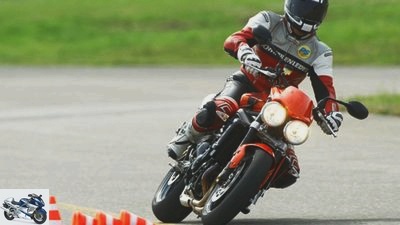
jkuenstle.de
accesories
landing gear & Spring elements
Handling test part 2: Triumph Street Triple R
Handling test part 2
The handling test with the Triumph Street Triple R.
Content of
After the large comparison of handling concepts in issue 8/2010, PS is now examining the effects of different chassis settings, air pressures, wheel weights and steering angles on the driving behavior of a Triumph Street Triple R..
Robert luck
09/21/2010
Can you remember how often you discussed the correct tire pressure during race training in the pits or at the regulars’ table? Or about light wheels and their positive effect on a motorcycle? Or about the correct setting of the chassis? Who does not know the story of a buddy of a buddy who, shortly before the start, on the advice of a competitor, lowered the air pressure of his skins again – and was thus wrong in the race?
Every committed motorcyclist knows one of these stories or questions, has witnessed or asked them himself, shaking his head. But what really happens when a sporty driver with a setup that is too soft, too little air pressure or a tail that is too low turns violently on the racetrack or country road? How are these deficits noticeable and what effect do they have on, for example, the lap time or your own driving experience?
In the second part of the handling test (part one in PS 8/2010), PS searches for answers to these questions with an extensive test program. First, the testers attacked on a slow handling course, followed by the move to the small but fine Anneau du Rhin racetrack near Colmar in France.
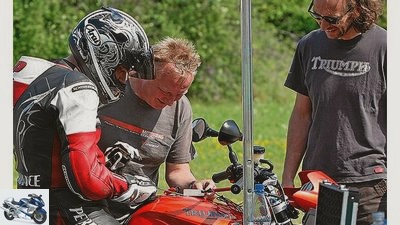
jkuenstle.de
One sweats, the other laughs, that’s a cheap way to make joy…
On the handling course, the Triumph was completely wired with a 2D data recording system Street Triple R missed a tight setup that is suitable for country roads. This was called on both routes “optimal setup” and is indicated as such in the boxes on page 31. In each test constellation, you had to do five laps. Give two to curl up and three to fire, although more than three quick test laps were often necessary on the racetrack to actually get three “trouble-free”, So to be able to record laps without overtaking maneuvers. The test procedure was identical on both routes, proceeding step by step in the same order. Step 1: warm up and get to know the route. Step 2: Test drive with the optimal setup. Step 3: test drive with “soft landing gear”, So with completely open compression and rebound damping on the front and rear wheel. Step 4: test drive with “flat landing gear”. With the fork fully preloaded, the preload of the shock absorber was reduced until the steering head angle was one degree flatter. Step 5: Test drive with a heavy rear wheel. Step 6: Test drive with heavy front and rear wheels. Step 7: Test drive with a heavy front wheel.
During the test, refueling was carried out after every turn and the tires were checked, while the recorded data was transferred to the laptop at the same time. Both the visual checks and the driving experience confirmed that the mounted Continental RoadAttack 2 had very good stamina for a touring sports tire with a high, constant level of grip – despite the prevailing heat on the racetrack. Out of a pure instinct for self-preservation, PS in Anneau du Rhin decided not to examine the lowered air pressure. The test drives with the pressure in the Conti tire reduced from 2.5 bar to just 1.8 bar only took place on the course, because the lack of feedback meant that the increased risk of falling and the much higher speeds on the racetrack seemed too risky. We also did without because the results of other test steps on the slow course strongly overlap with those on the racetrack, so the influences on driving behavior are analogous.
Test impressions
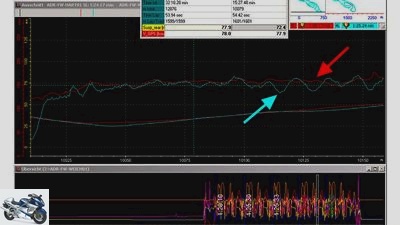
Drawing: archive
In the acceleration phase from the apex, the tail begins to pump (green line on the arrow). With firm damping (red line), the pumping movement does not occur, speed is built up faster and the tire is loaded more evenly.
Soft suspension setup: The Streety drives terribly, wobbles and swings through the area. Two factors are dangerous: The pumping of the hindquarters when accelerating out (16 mm up and down on the shock absorber, see green line in the data recording). It not only messes up the line, but also introduces load peaks in the tires, which overstrain them and can lead to slipping. The lack of feedback is just as dangerous. The pilot has hardly any feedback, there is no clearly noticeable limit and if there is no noticeable limit, he might fall.
Increased mass on the individual wheels: PS weighed one kilogram on the front wheel and two kilograms on the rear wheel. The heavier rear wheel is only noticeable in nuances when you step directly off the “light” Rear wheel changes. The heavy front wheel alone becomes conspicuous in the fast Flic-Flac (a fast alternating curve, see route sketch), because the motorcycle no longer turns in quite so willingly and follows the line.
Increased masses on both wheels: The Triumph seems more stubborn, the feeling increases in the fast passages, and the clean line requires more effort.
Landing gear one degree flatter: The steering force is slightly increased, and the Streety runs more arcs from the apex. Your swing angle is now too flat (insufficient preload), which leads to squadding when you accelerate out, i.e. the rear wheel is pulled into the spring. This effect reduces the suspension travel to a minimum, slides on bumps are programmed. This also makes the steering head angle even flatter, which reinforces the running wide.
Objective data
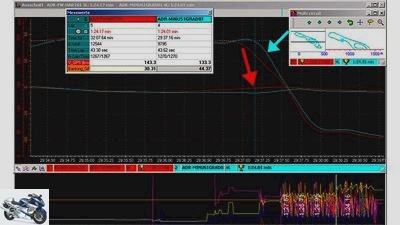
jkuenstle.de
If the geometry is optimal, the cornering speed increases (red arrow). Changing the lean angle with the flat steering head (green line and arrow) is slower and the bike stays leaned for longer, which costs speed.
The recorded values of speed, steering force and lean angle prove that a good, stable chassis enables the best values in all sections, both on the course and on the racetrack. However, the differences in lap or section times and speeds are not as serious as the driver perceives subjectively. The lower the speed, the lower the advantages of the optimally adjusted chassis. When turning hard in the fast Flic-Flac at speeds of around 140 km / h, the stable chassis gains significantly in meters. The heavy wheels are also very noticeable there, which leads to the lowest section speed of 132.0 km / h and increases the steering torque to 148 Nm.
By far the biggest problem for the driver is the enormous movement of the fork and shock absorber with the softly adjusted chassis, which increases the lap time by 1.27 s to 1.25.22 min. The poor damping allows only weak feedback between the tire and the driver. As a result, he can no longer correctly assess the limit area and slows down significantly, especially in the fast sections of the route. The situation is similar if the air pressure in the tires is too low (PS decreased from 2.5 bar at the front and rear to 1.8 bar on both tires). There is little feedback because the tire crumples and rolls and only implements steering commands indirectly.
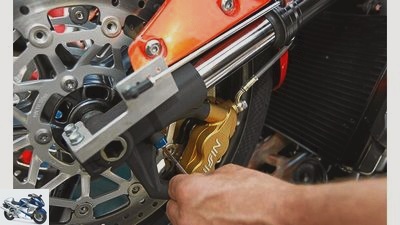
jkuenstle.de
The linear potentiometer records the spring movement on the front wheel, the magic screwdriver takes care of the setup.
With the chassis adjusted one degree flatter (steering head angle 65.1 instead of 66.1 degrees, which results in 99 mm caster instead of 93 mm), the driver has to work with significantly more steering force, but remains only 2/10 seconds behind the best time with an optimal lap time Landing gear back. However, these incorruptible measured values do not reflect one thing: The increased effort of the pilot reduces the driving pleasure.
Even the tester was amazed at how differently one and the same test motorcycle can ride. To the technician he said after the ride on the racetrack with a soft setup: “If I always had such a lousy chassis under my bum, I would stop riding a moped.”
And that’s exactly what fast motorcycling is all about. Knocking out a good time in a lap with a crowbar is one thing, risking your bones over a racing distance or expensive race training with a messed up chassis is another. Sure, you can get used to bad set-ups and drive quickly. But that doesn’t really get you any further. Because if you have to fight with the motorcycle in every corner and in every acceleration phase, you lose the fun of burning. And, as is well known, this occurs fastest when the motorcycle implements the driver’s steering commands quickly, precisely and with good feedback. Then you dare to go to your own limit, try a different, possibly faster line. But how do you get an optimal setup? Only one thing helps: try it out.
Conclusion: Riding a motorcycle fast is more than the pointless destruction of fossil fuels. It is the interaction of many impressions and feelings, but also many technical factors. However, if you want to experience mostly good feelings while driving, you have to make sure that the technical framework conditions are right.
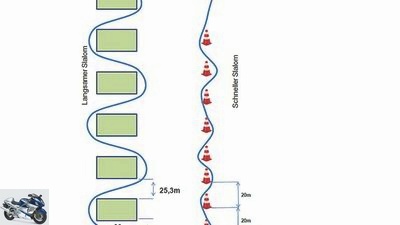
Drawing: archive
Already known from the first part of the handling test (PS 8/2010): the slalom course on the airfield.
Street Triple R slalom course (Neuhausen ob Eck)
| Changes | Best time* | More quickly Slalom**/ maximum Steering torque |
Slower Slalom***/ maximum Steering torque |
horseshoe | optimal chassis / Standard wheels |
1,18.41 min | 96.14 km / h 150 Nm |
58.84 km / h 118 Nm |
49.44 km / h |
| plus 1 kg on the front wheel |
1,19.66 min | 94.63 km / h 178 Nm |
57.75 km / h 122 Nm |
50.55 km / h | plus 2 kg on the rear wheel |
1,19.87 min | 93.70 km / h 170 Nm |
56.56 km / h 113 Nm |
49.79 km / h |
| plus 1 kg in front and 1 kg at the back |
1.19.90 min | 92.05 km / h 172 Nm |
57.55 km / h 103 Nm |
50.68 km / h | Landing gear one degree flatter |
1,18.77 min | 93.85 km / h 159 Nm |
56.98 km / h 105 Nm |
48.81 km / h |
| soft chassis | 1,19.41 min | 93.20 km / h 152 Nm |
56.92 km / h 92 Nm |
48.11 km / h | optimal chassis 1.8 bar tire pressure |
1,19.61 min | 92.21 km / h 148 Nm |
55.67 km / h 84 Nm |
50.05 km / h |
* Time for two laps (702 meters each) with a flying start.
** Average speed measured over a distance of 150 meters
*** Lane change left / right / left over a lane width of 6 meters steering torque / Nm determined from the two highest values.
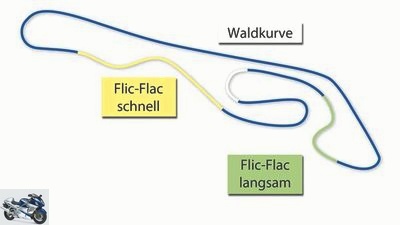
Drawing: archive
Anneau du Rhin near Colmar was perfect for the driving tests, as the course offers the very fast and the slow Flic-Flac.
Triumph Street Triple R in Anneau du Rhin
| Changes | Flick flack slow/ Steering torque * |
Forest curve maximum Inclined position |
Flick flack quickly/ Steering torque * |
best Lap time |
optimal chassis | 74.25 km / h 65 Nm |
76.47 km / h 46.1 ° |
139.2 km / h 140 Nm |
1.23.95 min |
| soft chassis | 73.21 km / h 84 Nm |
76.01 km / h 45.6 ° |
136.9 km / h 144 Nm |
1.25.22 min | plus 1 kg on the front wheel |
73.84 km / h 80 Nm |
74.4 km / h 45.8 ° |
133.5 km / h 146 Nm |
1.24.20 min |
| plus 2 kg on the rear wheel |
47.4 km / h 78 Nm |
74.5 km / h 45.4 ° |
132.6 km / h 143 Nm |
1.24.11 min | plus 1kg in front and 2 kg in the back |
73.6 km / h 73 Nm |
75.3 km / h
45.3 °
148 Nm
flatter
80 Nm
45.2 °
150 Nm
* Steering torque / Nm determined from the two highest values in each case
Related articles
-
Bilski motorcycles Comparison test: KTM 990 Super Duke, Moto Morini Corsaro 1200 Veloce, Triumph Speed Triple, Yamaha FZ1 Comparison test: KTM 990…
-
fact motorcycles Test: Triumph Street Triple R Test: Triumph Street Triple R Mr. R Content of Mr. R is a respectable person. Not because he wears a…
-
Triumph Street Triple – Series, Cup, Tuning
K motorcycles Triumph Street Triple – Series, Cup, Tuning Triumph Street Triple – Series, Cup, Tuning Family Day Content of Three sisters: they have a…
-
Triumph Speed Triple 1200 RS top test 2021
Arturo Rivas 28 pictures Arturo Rivas 1/28 In the top test with the Triumph Street Triple 1200 RS, the testers clearly had fun. Arturo Rivas 2/28…
-
Second-hand comparison: Triumph Street Triple (2007 to 2017)
Jacek Bilski 21 pictures Jacek Bilski 1/21 The offers for used Streety models start from 3,500 euros. Jacek Bilski 2/21 The Street Triple has…
-
Triumph Speed Triple 1200 RS: Almost everything new
News 2022 New motorcycle items for 2022 Triumph Motorcycles 44 pictures Triumph Motorcycles 1/44 The new Speedy 1200 RS has new headlights that are very…
-
fact motorcycles Comparison test: Honda CBR 600 RR, Kawasaki ZX-6R, Suzuki GSX-R 600, Triumph Daytona 675, Yamaha YZF-R6 Comparison test: Honda CBR 600…
-
Comparison test Ducati 1098S, Honda Fireblade, KTM 1190 RC8, Triumph Daytona 675, Yamaha YZF-R6
Jahn motorcycles Comparison test Ducati 1098S, Honda Fireblade, KTM 1190 RC8, Triumph Daytona 675, Yamaha YZF-R6 Comparison test Ducati 1098S, Honda…
-
Test winner tire test part 1 – touring tires (MOTORRAD 12-2015)
mps studio accesories tire Test winner tire test part 1 – touring tires (MOTORRAD 12/2015) Test winner tire test part 1 – touring tires (MOTORRAD…
-
Editor’s two-wheeler treasure: Triumph Street Triple
Jahn 12th pictures fact 1/12 At the Intermot, Triumph is presenting a completely redesigned Street Triple including the higher-quality R version with…